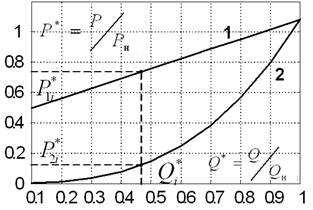Author's abstract
Introduction
Turbomechanisms are the machines of mass usage. It’s enough to say that approximately 28% of over energy, generated in the country is used for electro drive of the turbomechanisms. Pumps, ventilators and compressors are referred to them. One of the peculiarities of which is dependence of the resistance torque from the rotation frequency. The type of hydro or pneumatic net sufficiently influences the character of dependence which the turbomechanisms work for. The regime of turbomechanisms works is characterized with the productivity Q, rotation frequency ![]() , pressure H for pumps or P for ventilators. Pumps and ventilation machines have much in common, because they relate to one class of turbomechanisms, subjected to common principle of similarity [1].
, pressure H for pumps or P for ventilators. Pumps and ventilation machines have much in common, because they relate to one class of turbomechanisms, subjected to common principle of similarity [1].
Actuality of the research
The problem of energy and resources saving is up-to-date for the industrial and municipal economy. That’s why change from unregulated to regulated electric drives of the turbomechanisms with the aim of increasing of such parametes as energy resources saving, reliability, est. is one of the impotant trends of the scientific research, considering the fact that the given electric drives are one of the biggest consumers of energy.
The aim
The aim of this work is the increase of effectiveness of working of the turbomechanisms complexes while transforming their electric drives into the range of regulated ones.
Tasks
- analysis of the existing managing methods of turbomechanisms.
- Ground the effectiveness of usages of regulated electric drives.
- Mathematical description of the processes taking place in the turbomechanisms (systems of water or air supply).
- Analysis of the dynamic and static processes taking place in the turbomechanisms.
- Synthesis of managing systems of the turbomechanisms for increasing the effectiveness of their work.
- Elaboration of recommendations about the usages of different regimes of electric drives turbomechanisms management.
The main part
The main idea of using the regulated electric drive in the systems of automated management in the pump complexes is in supporting of the set of technological parameter without creating abundant meaning of others while changing the system work regime (for example water supply continuously changes at time according to the unexpected probable regularities. The range of changing is rather wide, it changes from (1/3):(1/2) [2]). The characteristics of ventilators are similar to the characteristics of pumps and the characteristics of air ducts are similar to the water-supply networks. The peculiarity of this is in the fact that ventilators work with networks without counterpressure.
Pump stations of water-supply systems or ventilators systems are the complex technical units of interconnected mechanical and electrical equipment, which are characterized with significant energy consume. That’s why providing of reliability and effectiveness of their functioning is the main demand for the objects of such kind.
Nowadays for the regulation of supply and pressure in the water-supply systems choking or regulating of working wheel frequency rotation of the centrifugal pump drive engine are used. Using the main dependencies which describe turbomechanisms work and dependency which determines torque on the drive engine shaft and guiding the fact that efficiency at frequency regulations and also at choking has different meanings, we can calculate power which is created with drive engine depending upon supply Q for the managing methods that are under investigation (graph 1).

Graph 1 – Dependency ![]() (choking (1) and frequency regulation (2))
(choking (1) and frequency regulation (2))
This graph shows that at choking for achieving the same meaning of the supply Q as it was at frequency regulation, more energy is used.
Conclusion
Transfer from unregulated to regulated pump and ventilate electric drive solves the question of technological regime management of units at energy expense reduction. The means of management are investigated in details in the author’s work.
Literature
- Струве Э.Э., Дик И.П., Старцев Г.С. Вентиляторы и насосы. М.: Машгиз, 1955.
- Лезнов Б.С. Энергосбережение и регулируемый привод в насосных и воздуходувных установках. — М.: Энергоатомиздат, 2006. 360 с. ил.
- Куряпов В. Н., Мальцев А. П. и др. Потенциал энергосбережения и его практическая реализация//Энергонадзор и энергоэффективность. 2003. №3.
- Ильинский Н. Ф. Электропривод: энерго- и ресурсосбережение: учеб. пособие для студ. высш. учеб. Заведений / Н. Ф. Ильинский, В. В. Москаленко. – М.: Издательский центр «Академия», 2008. – 208 с.
- Лезнов Б. С. Экономия электроэнергии в насосных установках. – М.: Энергоатомиздат, 1991. – 144 с.: ил. – (Экономия топлива и электроэнергии)
- Браславский И.Я., Ишматов З.Ш., Поляков В.Н. Энергосберегающий асинхронный электропривод. Под. ред. И.Я. Браславского. – М.: Издательский центр «Академия», 2004. – 256 с.
- Елисеева В. А. Справочник по автоматизированному электроприводу / Под ред. В. А. Елисеева и А. В. Шинянского. – М.: Энергоатомиздат, 1983. – 616 с.
- Онищенко Г. Б., Юньков М. Г. Электропривод турбомеханизмов. М., «Энергия», 1972 – 240 с.
- Черкасский В. М. Насосы, вентиляторы, компрессоры: Учебник для теплоэнергетических специальностей вузов. – 2-е изд., перераб. и доп. – М.: Энергоатомиздат, 1984. – 416 с.
- J. A. Fox. Reader in Civil Engineering University of Leeds. Hydraulic Analysis of Unsteady Flow in Pipe Networks. London, 1977.

